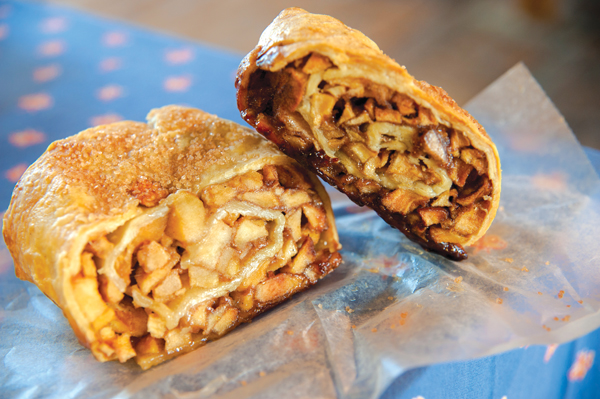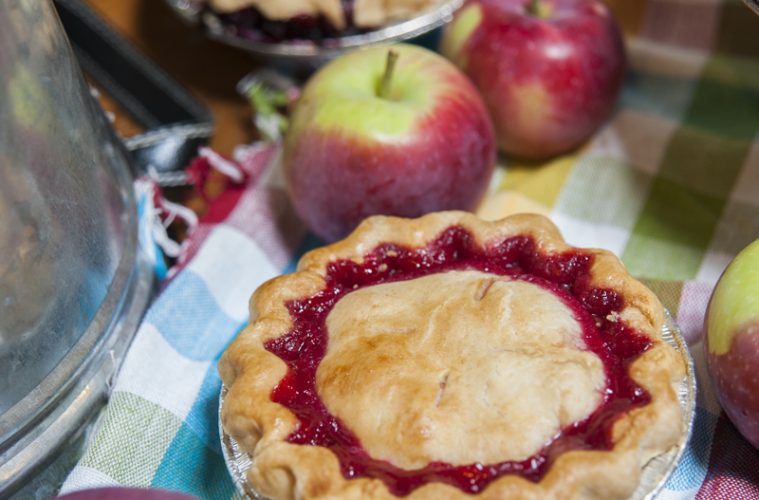When it comes to one of America’s favorite desserts, we all become Simple Simons.
When the the earliest settlers first arrived on the North Shore, they stepped ashore with pies in hand. Well, perhaps they did not literally hold a piece of pie as they disembarked, but as soon as they began to hunt and gather food, they were making and eating pies. That’s because the pie, now generally relegated to dessert status, was the original fast food. Wrapped in a pastry crust, the food could be carried and consumed anywhere, making it portable and easy to eat. In fact, making pie is an ancient practice—the Oxford English Dictionary traces the first use of the word “pie” as it relates to food in 1303, noting the word was well known and popular by 1362.
“The Colonists made meat pies; they were early sandwiches,” says David Bowie, owner of Salem Spice. “They used the locally available game—turkey, deer, squirrels, and rabbits. The pies were smaller [then], like modern pita pockets. For seasonings, they didn’t have a lot of pepper, but they used salt, oregano, cilantro, and sweet basil, which is also known as St. Joseph’s wort.”
By the early 19th century, sweet pies had won over America. But the taste for savory meat pies remains, especially in England. On this side of the pond, we opt for mincemeat at Thanksgiving, a vestige of our earliest pies.
Sweet Pies
Today, savory pies are less common here on the North Shore, except in the forms of calzones, empanadas, pierogi, pot pies, quiche, and shepherd’s pie. But hardly anyone can resist a slice of sweet pie for dessert or with a cup of coffee.
At the Agawam Diner in Rowley, customers delight in the variety of pies offered. “We bake all our own pies,” says manager Eric Galanis. “The mincemeat pie features apples and raisins, but no meat, which is the common recipe today.” Though fruit is what comes to mind when we first think of sweet pies, the single favorite pie flavor at the diner, says Galanis, is banana cream, with chocolate cream coming in a close second.
Elsewhere, apple still reigns supreme. “Half of all the pies we sell are apple,” says Joanna Fiore, the bakery manager at North Andover’s Smolak Farms. “We also sell a lot of pumpkin pies, and pecan pie is one of our most popular flavors at Christmas.”
Apple Varieties For Pie
“The best apples for pies ar e firm, so that the pieces will stay distinct when they are baked and when we freeze the pies over the winter,” says Pam Herndon, bakery manager at Russell Orchards in Ipswich. “Early in the season we use Gravenstein apples, mid-season we like Cortlands, and late in the season we use Baldwin apples.”
Both she and Fiore tout the pie-baking qualities of Cortland apples, which are large and easy to peel.“We also use some antique varieties,” Fiore says. “One of our favorites is Sheep’s Nose.” Beyond apple, favorite fruit flavors include peach, blueberry, cherry, strawberry, raspberry, and cranberry.
The Crust Conundrum
There was a practical reason the early North Shore citizens made pies: A piecrust used less flour than bread and did not require anything as complicated as a brick oven for baking. More important, though, was how pies could stretch even the most meager provisions into sustaining a few more hungry mouths. According to the Oxford Encyclopedia of Food and Drink in America, “No one, least of all the early settlers, would probably proclaim their early pies as masterpieces of culinary delight. The crusts were often heavy, composed of some form of rough flour mixed with suet.”
Today we eschew suet, though some inspired cooks still swear by lard, or a combination of lard and butter. At Smolak Farms, a secret Smolak family recipe features “lots of butter,” according to Joanna Fiore. The problem with piecrust is that it should be flavorful and tender while it is strong enough to stand up to the meat or fruit juices that will render the pie soggy.
The proportion of crust to filling is hotly debated by pie aficionados, dividing people into those who prefer the crust to those who love the filling. At Russell Orchards, the Apple Roll-Up walks the line between the two camps, as it brings back the concept of the pie as easily transportable finger food.
 Pie Perfection: The Apple Roll-Up from Ipswich’s Russell Orchards is pure pleasure Pie Perfection: The Apple Roll-Up from Ipswich’s Russell Orchards is pure pleasure |
“We make it with apples, sugar, and piecrust, then wrap it like a cinnamon roll and cut it into slices,” says Pam Herndon, who carefully guards the details of the recipe. “It tastes just like a piece of pie, but [it] is portable.”
As American As Apple Pie
While pie is on just about everyone’s favorite dessert list, pie baking has become the domain of home bakers and apple orchards, with most store-bought pies being churned out by large commercial bakeries. But here on the North Shore, we are richly blessed with local businesses that provide us with the genuine article.
At Methuen’s Mann Orchards, the bakery sells anywhere from 1,200 pies per week to over 26,000 during the week of Thanksgiving. Apple is, by far, the favorite flavor.
“We use whatever apples are available,” explains Matt Fitzgerald, who is both an owner and the general manager. “[We begin] with Ginger Gold and Gravenstein early in the year, then [move] on to Cortlands, and then the later varieties. Last year, there were only four days when we did not have apples. We only use our own apples—they are grown, peeled, and sliced here.” The hard winter apples keep through the spring and early summer, doing away with the need to resort to frozen, previously sliced, and commercially purchased products.
The orchard, which has been in business since 1877, has not changed its pie recipe in over 45 years. “For the crust, we use flour, salt, shortening, and water,” Fitzgerald says. “Nothing else.” It is, indeed, an all-American favorite.
Local Haunts For Sampling Sweets
Salem Spice, 75 Wharf St., Salem, 978-744-6678, salemspice.com
Agawam Diner, 166 Newburyport Tpke., Rowley, 978-948-7780
Smolak Farms, 315 South Bradford St., North Andover, 978-682-6332, smolakfarms.com
Russell Orchards, 143 Argilla Rd., Ipswich, 978-356-5366, russellorchards.com
Mann Orchards, 27 Pleasant Valley St., Methuen, 978-683-0361, mannorchards.com
Recipe for Early Pie Crust:
From The Art of Cookery Made Plain and Easy by Hannah Glasse, c.1747, “A Standing Crust for Great Pies”
“To a peck of flour the yolk of three eggs, then boil some water, and put in half a pound of fried suet, and a pound and half of butt er. Skim off the butter and suet, and as much of the liquor as will make it a light good crust; w ork it up well, and roll it out.”

